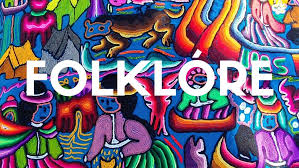FOLKLORE
What is Folklore?
Folklore generally refers to cultural
expressions, such as narratives, jokes, beliefs, proverbs, legends, myths,
music, songs, dances, costumes, food, and festivals, through which individuals
and groups shape and disseminate a shared identity. There is, however, hardly
any consensus among folklorists on either how to define folklore or how to
explain the issues with the meaning and the function of it.
The interest in folklore emerged primarily out of the Romantic nationalism of the early nineteenth century. Enthusiastic intellectuals, amateurs, and artists started to collect different kinds of folklore material in order to be able to study various aspects of ‘the folk’ and folk-life.
During this early period, folklore was viewed as ‘the lore’ – the materials of folklore – of ‘the folk’ – the people who utilize the materials. The discoverers of folklore identified the ‘folk’ as peasant society or rural groups, regarding them as the main carriers of distinct traditions that were slowly dying out due to urbanization and industrialization during the transition to modernity. The bourgeois nostalgia for the ‘paradise lost’ motivated the efforts to examine and preserve different aspects of folk-life. In some countries, the rising interest in folklore studies was also motivated by the eighteenth-century Enlightenment. Within this perspective, the folk and their traditions were regarded as primitive and therefore had to be studied in order to be transformed. Early folklorists focused primarily on oral traditions, such as ballads, folktales, epics, and sagas, and how these were transmitted within rural communities.
During the 1960s, a paradigm shift occurred in the theory and methods of folklore studies. Folklorists became aware of the class, gender, and national bias embedded in the old concept of folklore. Moreover, contrary to earlier research that approached folklore as authentic and ahistorical artifacts, new research streams pointed out that folklore was always situated within some particular space and time. Recent folklore studies tend to view folklore as process-centered, context-sensitive, and performance-oriented. According to a contemporary influential conception of folklore, ‘folk’ refers to any group of people who share some common grounds, such as occupation, language, religion, or ethnicity. Most people are members of several and not just one folk-group. The paradigm shift allowed the expansion of folklore studies into new areas of inquiry that previously received little attention.
Folklore studies (alt. folkloristics) as a discipline continues to struggle for its place in the academic world, where it rarely has achieved an autonomous status. In most countries, folklore is studied within the neighboring fields of ethnology, anthropology, cultural studies, literature, or history. Folklore material is primarily collected through fieldwork, participant observation, and interviews. Various kinds of secondary sources, such as archival materials, diaries, autobiographies, letters, and photography, serve as excellent sources of folkloric imagination. The availability of sources, however, varies both geographically and chronologically. Inasmuch as ‘folk culture’ was long considered to be of low status and was denned in opposition to ‘high culture’, records of it sometimes exist only as selected and filtered by the latter. When folkloristics as a scholarly endeavor emerged in the West, it was primarily oriented toward documenting Western folklore. Collecting folklore from other parts of the world was done occasionally by missionaries, travelers, and anthropologists. There are also examples that colonial powers not only actively discouraged but even banned native scholars from collecting folklore expressions. In recent discussions on the state of folklore scholarship, there have emerged claims that contemporary folklorists must direct attention even toward the political aspect of folklore research in order to be aware of who is studying whose traditions and on what terms.

Comments
Post a Comment